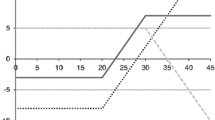Abstract
The aim of this study is to examine the return rates of the TAIEX options with at most 8 calendar days to maturity using a buy-and-hold strategy. Although our results generally reveal that the index option returns are significantly negative, we also find that whilst the return rates of monthly-expiring calls are inferior to those of weekly-expiring calls, the return rates of monthly puts tend to be less negative than those of weekly puts. Furthermore, as monthly (weekly) options approach their maturity dates, the underlying index returns are found to be negative (positive). Risk-neutral volatility and skewness are used to measure the respective fear and pessimism levels among investors towards the stock market, and indeed, we find that as the expiration date approaches, there is a discernible increase in both the fear and pessimism of investors with regard to monthly options, as compared to a reduction for weekly options.
Similar content being viewed by others
Notes
Although weekly S&P 500 index options have had longer shelf lives out to almost 5 weeks, Chatrath et al. (2015) employed in a majority of tests the data spanning the interval January 2011 through May 2012, when weekly options had a shelf life of just 1 week.
In the discussion herein, the gross ROR rather than the rate of excess return is employed.
Andersen et al. (2017) suggest weekly options can provide precise information for the tails of the risk-neutral distribution.
The TAIEX is a value-weighted index which includes almost all firms listed on the Taiwan Stock Exchange (TWSE). At the end of 2014, the number of firms listed on the TWSE stood at 854.
A single point is equal to NTD50. On 23 March 2017, 1 USD can be approximately converted 30 NTD.
It is worthwhile to explain why huge daily negative returns result in large positive holding period returns in Tables 3 and 4. For instance, suppose that the holding-period returns are − 100, − 100, − 100 and 350%, and that their holding periods are all 3 days. According to the formula for daily rate of return presented above, the daily return rates are − 100, − 100, − 100 and 65%, respectively. Consequently, the average holding-period return is 12.5%, while the average daily return is − 59%.
When the TAIEX return rate during the option holding periods was converted into the daily return rate, the sign of the average daily return rate remained unchanged; however, there were reductions in the absolute values. Given that the index was at 8000 points, the average TAIEX daily fluctuations corresponding to the respective monthly and weekly option holding periods were approximately − 3 points and 3 points.
The data were obtained from the Central Bank of Taiwan website.
References
Amin, K., Coval, J. D., & Seyhun, H. N. (2004). Index option prices and stock market momentum. Journal of Business, 77, 835–873.
Andersen, T. G., Fusari, N., & Todorov, V. (2017). Short-term market risks implied by weekly options. Journal of Finance, 72(3), 1335–1386.
Bakshi, G., Kapadia, N., & Madan, D. (2003). Stock return characteristics, skew laws and the differential pricing of individual equity options. Review of Financial Studies, 16, 101–143.
Bakshi, G., & Madan, D. (2000). Spanning and derivative-security valuation. Journal of Financial Economics, 55, 205–238.
Balanda, K. P., & MacGillivray, H. L. (1988). Kurtosis: A critical review. American Statistician, 42, 111–119.
Barberis, N., & Huang, M. (2008). Stocks as lotteries: The implications of probability weighting for security prices. American Economic Review, 95, 2066–2100.
Bauer, R., Cosemans, M., & Eichholtz, P. (2009). Option trading and individual investor performance. Journal of Banking & Finance, 33, 731–746.
Bollen, N. P., & Whaley, R. E. (2004). Does net buying pressure affect the shape of implied volatility functions? Journal of Finance, 59, 711–753.
Boyer, B., & Vorkink, K. (2014). Stock options as lotteries. Journal of Finance, 69(4), 1485–1527.
Chatrath, A., Christie-David, R. A., Miao, H., & Ramchander, S. (2015). Short-term options: clienteles, market segmentation, and event trading. Journal of Banking & Finance, 61, 237–250.
DeCarlo, L. T. (1997). On the meaning and use of kurtosis. Psychological Methods, 2, 292–307.
Dennis, P., & Mayhew, S. (2002). Risk-neutral skews: evidence from stock options. Journal of Financial and Quantitative Analysis, 37, 471–493.
Ederington, L., & Guan, W. (2002). Why are those options smiling? Journal of Derivatives, 10, 9–34.
Ederington, L., & Guan, W. (2005). The information frown in option prices. Journal of Banking & Finance, 29, 1429–1457.
Han, B. (2008). Investor sentiment and option prices. Review of Financial Studies, 21, 387–414.
Jiang, G. J., & Tian, Y. S. (2005). Model-free implied volatility and its information content. Review of Financial Studies, 18, 1305–1342.
Jiang, G. J., & Tian, Y. S. (2007). Extracting model-free volatility from option prices: An examination of the VIX index. Journal of Derivatives, 15, 35–60.
Kahneman, D., & Tversky, A. (1979). Prospect theory: An analysis of decision under risk. Econometrica, 47, 263–292.
Lakonishok, J., Pearson, N. D., & Poteshman, A. M. (2007). Option market activity. Review of Financial Studies, 20(3), 813–857.
Pan, G., Shiu, Y., & Wu, T. (2014). The effects of stochastic volatility and demand pressure on the monotonicity property violations. Journal of Derivatives, 22, 90–102.
Pan, G., Shiu, Y., & Wu, T. (2015). Investor beliefs and the demand pressure of index in taiwan options. Journal of Futures Markets, 35(12), 1117–1132.
Shiu, Y., Pan, G., Lin, S., & Wu, T. (2010). Impact of net buying pressure on changes in implied volatility: before and after the onset of the subprime crisis. Journal of Derivatives, 17(4), 54–66.
Tversky, A., & Kahneman, D. (1992). Advances in prospect theory: Cumulative representation of uncertainty. Journal of Risk and Uncertainty, 5(4), 297–323.
Whaley, R. E. (2000). The investor fear gauge. Journal of Portfolio Management, 26, 12–17.
Author information
Authors and Affiliations
Corresponding author
Rights and permissions
About this article
Cite this article
Pan, GG., Shiu, YM. & Wu, TC. Is trading in the shortest-term index options profitable?. Rev Deriv Res 22, 169–201 (2019). https://doi.org/10.1007/s11147-018-9147-9
Published:
Issue Date:
DOI: https://doi.org/10.1007/s11147-018-9147-9




